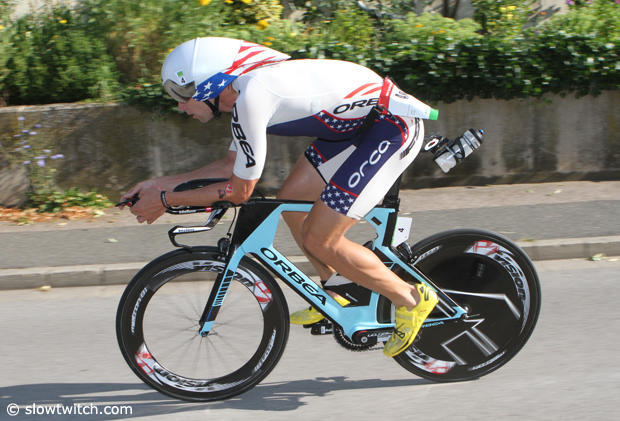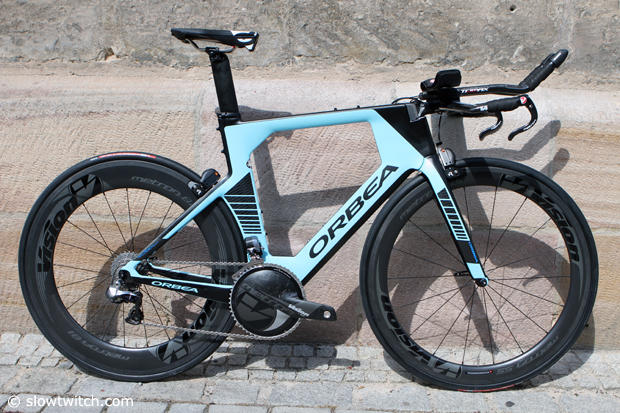Starykowicz in full
Andrew Starykowicz rode his 4:03:35 at Ironman Arizona, and lived to finish in a more-than-credible 8:05:56. I thought Slowtwitchers might want to read about what Andrew had to say about his race.
Andrew has a reputation for being a wallflower, devoid of opinions, incapable of controversy. Accordingly and as you'll see, it required all my skill and examinational powers to draw him out.
Yeah.
Slowtwitch: The first time you showed up on my radar was maybe 2009. At that time you were riding Orbea, and so was Craig Alexander. He was Orbea's triathlon star, you were racing the Life Time series. In 2011 things changed. Crowie decided Orbea wasn't for him going forward, but you stayed the course. It seems to have worked out well for both of you.
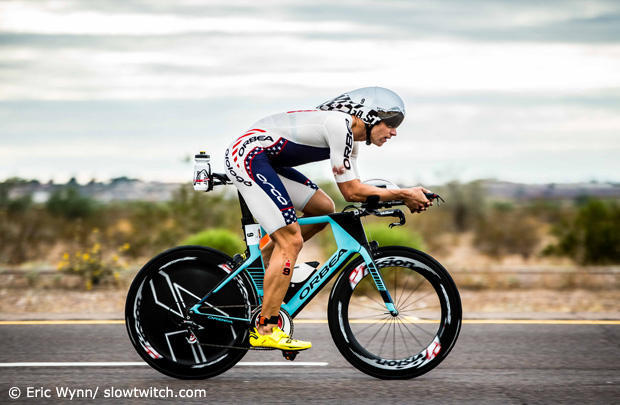
Andrew Starykowicz: The whole Crowie/Orbea firestorm was both great and a nightmare for me. At the end of the day the fallout was a lot of smoke and mirrors. If you look at his bike fit and choice of equipment pre-2011 he looked like a middle of the pack age grouper with a road helmet, bars that were stacked to the ceiling so it looked like he was riding a 1920's John Deere tractor. In 2011 at Abu Dhabi, he came out wearing a TT helmet, a Lazer Tardiz, riding a legitimate aero position, and changed from a two-piece with pockets jammed with nutrition to a much sleeker look. I watched him struggle through much of the season and in his head it was the bike, but in reality his body was adapting to the new position. His new "position" was to leave Orbea in the middle of a contract and destroy the image of a company that had backed him in earning multiple World Championships.
This left Orbea with me and gave me a shot to make a name for myself as the face of a 170-year-old employee-owned company. I capitalized on this by ending up injured and stuck in an Abu Dhabi prison for the spring of 2012. By the end of 2012 I was able to utilize the tools available to Crowie and ride a world record 4:04 at Ironman Florida en route to winning my second Iron-distance race. On the flip side Specialized took advantage of Crowie's new position and claimed their bike was what made him faster when pictures show it was likely all just due to a proper bike fit.
Slowtwitch: The first replacement for the original Orbea Ordu tri bike came out in 2012 with the OMR. In 2015, this past August, we saw the new OMP. Can you take us through the development of these models since the older Ordu. What you liked, what you didn't like, and how you feel about the bike you're riding now?
Andrew: Evolution for bikes is simple: faster, lighter, drive better. The OMR, it was a lot of fun to be part of the design process. I was like a kid in a candy shop getting to test how different things affect the aerodynamics of the bike. The OMR had a lot of integration, but we learned that all this integration was keeping up with the Joneses and not really bringing us free speed. So we set out to build a faster bike that was user friendly, and we did it. The most impressive part about the new OMP is, well, everything, starting with a superior leading edge in the free-flow fork followed by a bike frame that plays aerodynamic tricks on the wind. With help from Mondragon University the tube shapes were designed to take turbulent air off the rider and frame and make it laminar, reducing the drag of the bike. The bottom bracket stiffness is stellar, the handling, well, "designed in the heart of the Pyrenees," which means it can handle like a race car. The OMP is the new standard in TT bikes, and your article that you wrote earlier this fall acknowledges it.
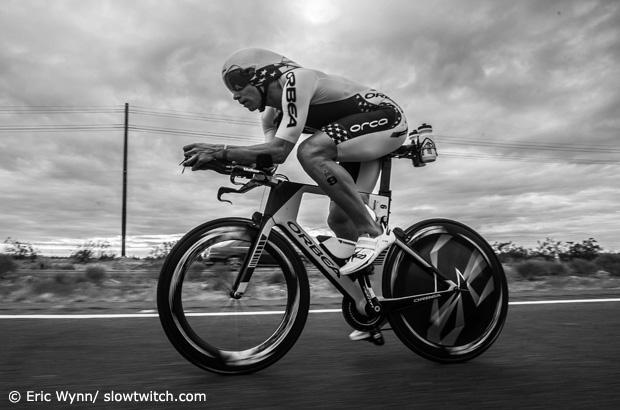
Slowtwitch: I was nosing around Slowtwitch a few days ago and it dawned on me that the image on the Recon Jet ads is of you. What do you, or did you, have to do with this product?
Andrew: I have been involved in a lot of the cool technologies that have come to market in the last few years. My two most recent have been the Recon Jet and Zwift. On the Recon side there has been a ton of work to get the Jet to a level in which a consumer puts it on his head and is speechless. In a sentence, we have made him the most complete and advanced piece of athletic equipment ever, which leaves you saying "I can." I can see live road maps with GPS, see power, heart rate, speed/pace, take movies, pictures, link to my phone so I can see whose calling, stream my position live, and I never have to take my eyes off the road. It also comes with spare batteries that you can change on the fly and lenses so you can train day or night. It has been great working to develop the product so that when it got to market the end-user salivates when he puts it on for a ride and is not disappointed in the experience. I get excited just talking about how far we've come.
Slowtwitch: You've been swapping back and forth between Lazer and Giro helmets, just like Jordan who's been swapping between the POC Cerebral and his Specialized McLaren. Have you found a permanent home for your head yet?
Andrew: I have done a lot of testing with different helmets and even modified a few of them seeing if I can reduce the drag, but right now I am madly in love with my Lazer Wasp. I don't know if it is because of the awesome paint job I did on it in my basement or if it is because the helmet is just super fast.
Slowtwitch: You are one of the engineer-pros, like Jordan, TJ Tollakson and others. You guys have a tendency to be picky about products. You always seem to ride with thought given to your drive train. Last year you had a big-time ride at Roth, and of course some big rides since. You typically ride with coated or treated chains and special bearings. It's either CeramicSpeed or Atomicss. What do you think this gives you? Are you do-as-I-say, not-as-I-do guy, or do you really get in there and clean your rig spotless before you race? And, what do you use for lube? Squirt? Or your own special sauce?
Andrew: At Caterpillar I was continuously in the field, testing excavators, and learned how to write a solid testing protocol so that you minimize noise, so you can repeat a test in two different locations with different operators and get the same results. I have applied this to my bearings and drive train.
I have tested a lot of products over the last few years. A lot of promises that are out on the market just are not reality, but when you make a testing protocol for yourself and start doing benchmark and repetitive tests you learn things that make you faster. I will simply state that I will keep my FSA Ceramic bearings and send them to Atomic High Performance for a little extra zing zing.
On the drive train side my love stays with the Atomic coatings. I have tried and even raced with a lot of the other so-called fastest products on the market and they just don't test and perform on race day like I have found the Atomic drive train does. Oh, and my drive train is clean on race day.
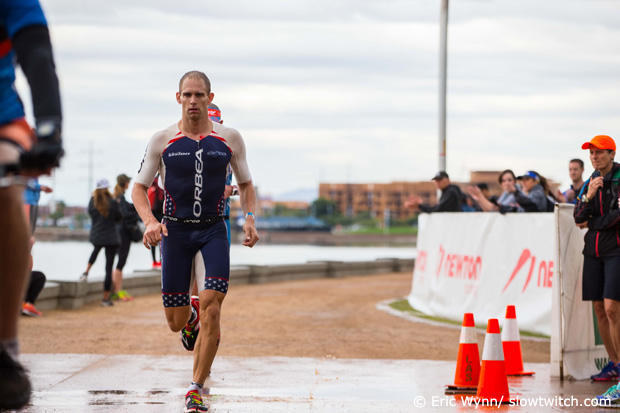
Slowtwitch: What power meter are you using and are you tempted to try anything else?
Andrew: Being from the midwest, PowerTap is where my loyalty lies. I have been on a PowerTap since 2005 and they have inadvertently driven me to push my body beyond the limit trying to achieve crazy power numbers since the day I got it. This year I got a set of their pedals and have been truly impressed. It has been entertaining to train with both the pedals and the hub this year and I have learned that friction loss in the drive train is constant and neither cadence nor power really effect drive train friction that much. A well-maintained drive train is around 3% loss from pedals to rear hub. There are long rides I have done in the rain where I have watched the drift slide from 2.8% to 7% just due to the rain gunking up the chain, gears, and bearings.
Slowtwitch: What kind of power did you hold in Arizona? And cadence? And did either change much throughout the race?
Andrew: In Arizona I held watts and a lot of them. For the first 94 miles I was dead steady on my heart rate and used the gears to maintain a harmonic 85-95 RPM. The power drifted up and down, up and down throughout the ride, then with 30-minutes left in the ride I elevated the cadence a bit and dropped the heart rate to get myself ready to run.
Slowtwitch: Do you have a power file from Arizona? And can we have it?
Andrew: Yes, no. You get to see the results on race day, the power file really means nothing unless you look at the nearly 300 bike rides I do a year to get to that point for it to mean anything.
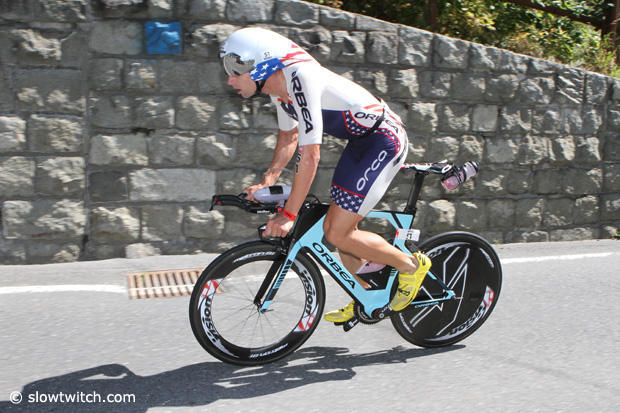
Slowtwitch: How do you determine what power you're going to ride in an Ironman?
Andrew: I don't, my body does. I work with Bob Duncan of Veritas Endurance to look at the last months of training and set heart rates to hit on the bike. I then go out and hit those heart rates, I use different cadences to maximize my power at a heart rate and chase gears all day playing the game of can I go faster with a higher cadence or lower cadence without changing heart rate. The power file is just a by-product.
Slowtwitch: You seem to say that you were riding more to your heart rate than to your power. What was the most important metric to you during that race, while on the bike?
Andrew: Heart rate in races. Power in training.
Slowtwitch: Usually, if power is maintained, riding a faster cadence actually increases heart rate. So near the end of the ride, if you increased your cadence and your heart rate went down, my guess is that you also backed off the power.
Andrew: You are correct, power plummets the final few miles.
Slowtwitch: What did you eat and drink and where do you keep your fluid and food while on the bike?
Andrew: I have worked with Infinit to get a custom formula that is seamless. I pushed the limits to get the salt, proteins, and carbohydrates I need in liquid form so that a few bottles of concentrate will get me through a race with nothing hanging off my bike or relying on aid stations.
Slowtwitch: Are you going to try to break 4 hours in an Ironman bike ride?
Andrew If it happens, it happens. It is a pie in the sky but I like winning a lot more.
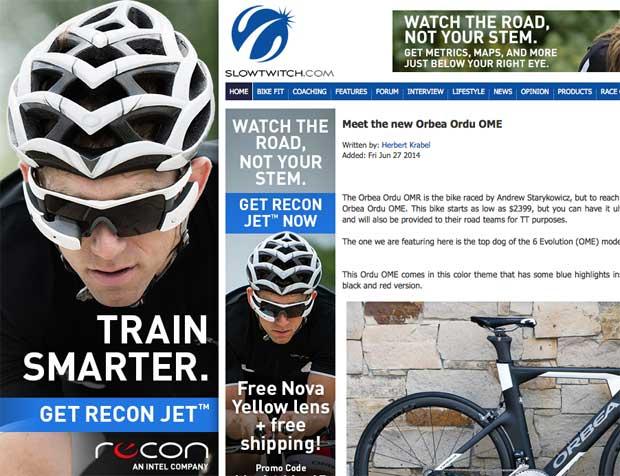
Slowtwitch: Have you tested your clothing? Shoe covers and skin suits? Do you have a sense for what you get in terms of watts or speed or time?
Andrew: Dan, I have tested a ton when it comes to clothing. I have learned hydrodynamic does not always mean aerodynamic and vice versa. The calculation is always constant in triathlon, will the time to take on and off or adjust this garment be made up in another part of the race.
Example one, sleeved versus sleeveless: At Miami the race was no wetsuits on the swim, so I decided to wear a sleeveless kit. Yes it is slower on the bike, but the Orca Hydro Killa is fast in the water which meant I did not need to wear a swim skin in the water, nor would I have to pull on a sleeved kit running to my bike. This also means that with a fast T1 I could drop nearly everybody before their shoes were in the pedals. It changes how you ride if they never have a chance to legally draft you, you don't have to throw in leg blowing surges to drop them.
Example two, shoe covers: some shoe covers are 5 watts faster, if they have a ripple in X location they are slower, they take 10 seconds to pull on, 5 seconds to pull off, on a sunny day your feet heat up and swell which can be a setback in T2 when trying to put on run shoes, over 90k 5W is circa-38 seconds, is all the risk versus such a little reward? At Austin where the high for the day was in the low 60's and coming out of the water the temp was in the high 40's I felt they were worth it.
It is often monkey-see, monkey-do in this sport. I have fallen victim to it early in my career but lately I lay out the facts, test, and then calculate when would it be appropriate to race this device. Orca makes a lot of cool stuff and all of it has a specific purpose, and weather willing I will race in all of it some day!
Slowtwitch: Is your position entirely power and comfort generated? If you made a positional change to reduce drag, what was it?
Andrew: My position is constantly getting tweaked. I am greedy and good is the enemy of great, and I feel I am just good, so I strive for great. A power-generated position is back around 75 degrees, a super aero position is up around 80-degrees with short cranks. As for comfort, the most comfortable place is on the couch in my NormaTec boots. Comfort is important when it comes to time trial efficiency, it does not matter how aero you are or can be if you cannot get in that position and stay there. While I have not figured out how to get my couch effectively on my bike, ProLogo has worked with me using heir CPC technology to design a saddle that allows me to deliver maximal speed.
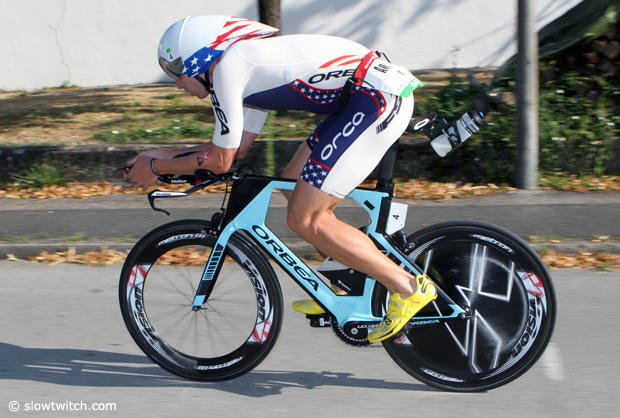
Slowtwitch: Do you know how much drag you generate at 30mph?
Andrew: I don't know how much in grams or watts. I know that country miles go by in less than 2 minutes at 425 Watts in training.
Slowtwitch: You're riding some old school cabled shift systems, aren't you? Are you just getting paid a lot of money to ride it, or do you specifically like it?
Andrew: I am a mechanical engineer, electronics are like kryptonite! In all seriousness the Vision drive train is wicked fast. I have tested 1x, Di2, and a lot of other things but the fastest has been the Vision drive train. Everybody commented and laughed about Ceramic Speed's monster derailleur [Andrew probably means Ceramic Speed's oversize derailleur pulley system] at Interbike, but Vision has silently been making an aero rear derailleur with 15t for a few years now (11t has been the standard) and it is wicked fast.
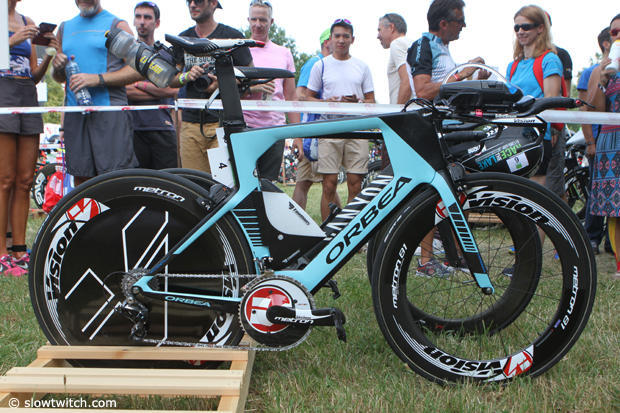
Slowtwitch: And finally the big question everybody wants to have asked. If you rode 5 minutes slower in an Ironman, would you run 6 minutes faster? Before you answer, in 1995 Thomas Hellriegel rode 11 minutes faster than Jürgen Zäck in Kona, and 17 minutes faster than Mark Allen and most of the rest of the top-10, and got ran down by Mark. In 1997 he rode 2 minutes slower than Zäck, and then between 8 and 12 minutes faster than the rest of the top-10, and he won the race. Of course there's more to the story, such as, he didn't have a Mark Allen or a Luc Van Lierde running a 2:41 marathon in 1997. And, Stadler did his best work when he throttled everyone during the bike leg. So can you tell the readers about the Starykowicz strategy, why it is what it is, and what you think riding slower would do to your overall race?
Andrew: Dan, point taken. My race is quite simple: number-1, get away, number-2, establish the metronome, number-3, finish first. Fighting to Win & Punish.


